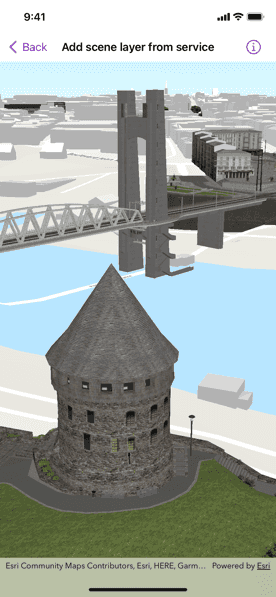Display an ArcGIS scene layer from a service.

Use case
Adding a scene layer from a service allows you to author the scene layer elsewhere in the platform, say with ArcGIS Pro or CityEngine, and then add that scene layer to a scene in ArcGIS Maps SDK. Loading a scene layer from a service also permits the layer source to change dynamically without updating the code.
How to use the sample
Pan and zoom to explore the scene.
How it works
- Create a
Sceneobject with a topographic basemap style. - Create a
Surfaceobject and add anArcGISTiledElevationSourceto it. - Set the surface to the scene's base surface.
- Create an
ArcGISSceneLayerwith a URL and add it to the scene's operational layers. - Create a
SceneViewwith the scene.
Relevant API
- ArcGISSceneLayer
- Scene
- SceneView
About the data
This sample shows a Brest, France Scene hosted on ArcGIS Online.
Tags
3D, buildings, model, scene, service, URL
Sample Code
AddSceneLayerFromServiceView.swift
// Copyright 2022 Esri
//
// Licensed under the Apache License, Version 2.0 (the "License");
// you may not use this file except in compliance with the License.
// You may obtain a copy of the License at
//
// https://www.apache.org/licenses/LICENSE-2.0
//
// Unless required by applicable law or agreed to in writing, software
// distributed under the License is distributed on an "AS IS" BASIS,
// WITHOUT WARRANTIES OR CONDITIONS OF ANY KIND, either express or implied.
// See the License for the specific language governing permissions and
// limitations under the License.
import ArcGIS
import SwiftUI
struct AddSceneLayerFromServiceView: View {
/// A scene with topographic basemap and a 3D buildings layer.
@State private var scene: ArcGIS.Scene = {
// Creates a scene and sets an initial viewpoint.
let scene = Scene(basemapStyle: .arcGISTopographic)
let point = Point(x: -4.4978, y: 48.3828, z: 62.0133, spatialReference: .wgs84)
let camera = Camera(location: point, heading: 41.65, pitch: 71.2, roll: 0)
scene.initialViewpoint = Viewpoint(boundingGeometry: point, camera: camera)
// Creates a surface and adds an elevation source.
let surface = Surface()
surface.addElevationSource(ArcGISTiledElevationSource(url: .worldElevationService))
// Sets the surface to the scene's base surface.
scene.baseSurface = surface
// Adds a scene layer from a URL to the scene's operational layers.
scene.addOperationalLayer(ArcGISSceneLayer(url: .brestBuildingService))
return scene
}()
var body: some View {
SceneView(scene: scene)
}
}
private extension URL {
/// The URL of a Brest, France buildings scene service.
static var brestBuildingService: URL {
URL(string: "https://tiles.arcgis.com/tiles/P3ePLMYs2RVChkJx/arcgis/rest/services/Buildings_Brest/SceneServer/layers/0")!
}
/// The URL of the Terrain 3D ArcGIS REST Service.
static var worldElevationService: URL {
URL(string: "https://elevation3d.arcgis.com/arcgis/rest/services/WorldElevation3D/Terrain3D/ImageServer")!
}
}
#Preview {
AddSceneLayerFromServiceView()
}